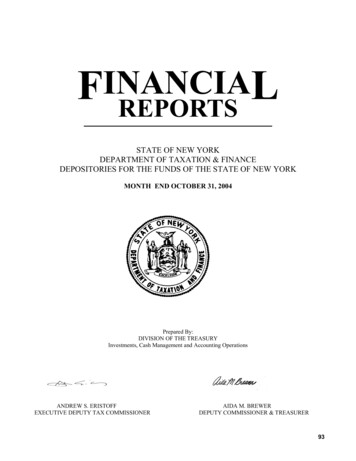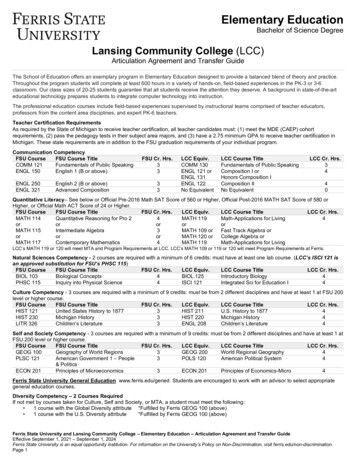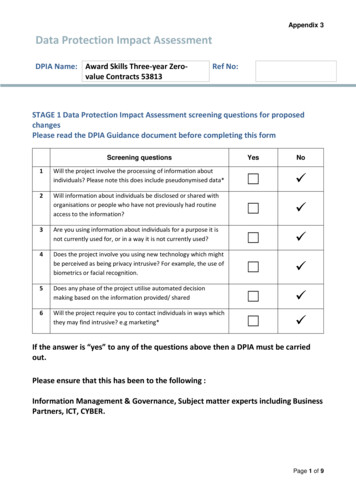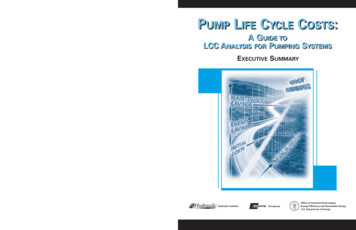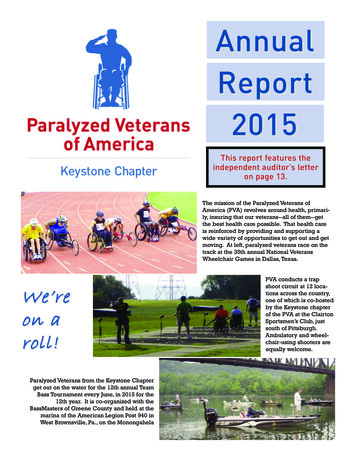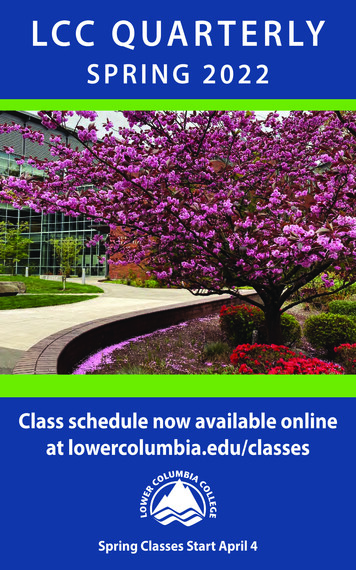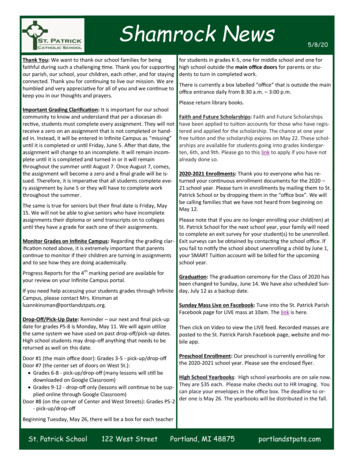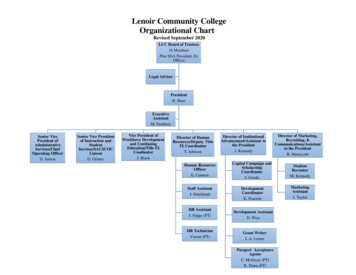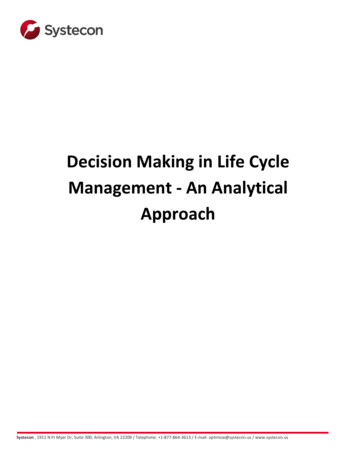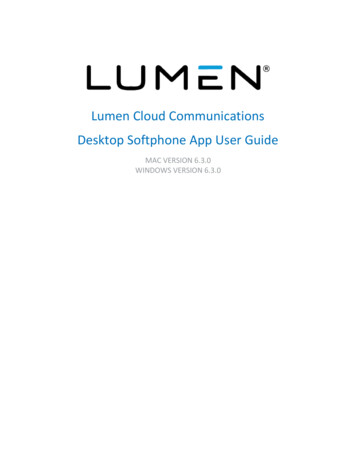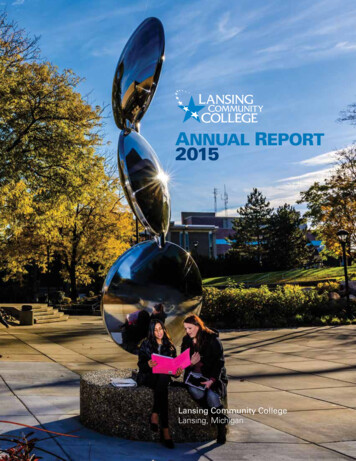
Transcription
ANNUAL REPORT2015Lansing Community CollegeLansing, Michigan
L A N S I N GC O M M U N I T YC O L L E G E2 0 1 5A N N U A LR E P O R TDecember, 2015Greetings:Throughout our proud history, Lansing Community College has maintained its commitmentto delivering exceptional services and education that open doors, change lives, and improveour communities.The College’s renewed emphasis this year has been on student success, and college andcareer readiness. We initiated 2015 with the launch of Operation 100%, a college-wideinitiative whose goal is to enable 100 percent completion for students in degree, certificate,or transfer pathways.An economic impact study conducted this year, by a third party, measured the economic,employment, and revenue impact of LCC. The report indicated that the College provides 1 billion to the region annually. We are proud to be one of the primary and most reliableeconomic engines and workforce development partners in the region. Moreover, of the28 community colleges in Michigan, LCC’s tuition is tied for the lowest in the state.With our excellent faculty, focus on student success, and cutting-edge teaching andlearning environment, LCC is an outstanding value, especially in comparison of the firsttwo years at a university.LCC also continues to respond creatively to the rapidly shifting needs of high schoolgraduates, career changers, and individuals looking to upgrade their skills. LCC increasedtraining deliverables by 18 percent from 2014-2015, while maintaining a 97.5 percentcustomer satisfaction rating.LCC’s ambient learning environment, science labs, facilities, and grounds rival the best inthe nation. When coupled with our teaching faculty, excellent customer service, guidedpathways, and student success focus, LCC will continue to be a campus and college likeno other of which the community can be proud. The overarching goal in all that we do isfor the community to value the College as an important asset and partner in the region.Sincerely,Brent KnightPresident1lcc.edu
L A N S I N GC O M M U N I T YFAST u2 0 1 5Lansing Community College, founded in 1957, is the thirdlargest community college in Michigan, serving a six-countyarea and enrolling 15,000 students each year.The College offers approximately1,150 courses each academic yearin general education, career and workforce development, developmentaleducation, and personal enrichment.nnC O L L E G EStudents interested in transferringto a university can earn generaleducation credits from credentialed and experienced faculty, ata reasonable cost, at convenienttimes, and in small classes.To ensure a smooth transition to auniversity, the college has articulationagreements with 47 institutions.Career and workforce programsat LCC are designed to prepareindividuals for specific jobs andcareers or to improve existing skills.Programs range from short-termcertificates to two-year degrees.Transitional and developmentaleducation courses in reading,writing, mathematics, English asa second language, and studentdevelopment help students at alllevels of preparedness gain theskills they need to be successfulin college.Personal enrichment and community education courses enablestudents of all ages to brush up onskills or explore areas of interest.Youth programs, including enrichment programs for gifted andtalented youth and summer camps,are also available.LCC offers more than 230 associatedegree and certificate programs.From 2014–15, LCC offered 1,101sections in 232 courses online;15 associate degrees and certificatescan be earned through online study.2nnnnnnnnMore than 3,400 degrees, credentials,and certifications were awarded in2014–15.A N N U A LECONOMIC IMPACTFiscal Year 2013R E P O R TThis study considersLCC as an investmentfrom the perspectivesof students, society,and taxpayers.From 2013–14, More than 1,590 LCCstudents transferred to universitiesto continue their education.The College has 3 1 agreementswith nine universities in Michigan,including Central Michigan University,Ferris State University, and Northwood University.Through the University Center atLCC, students can earn bachelor’s andmaster’s degrees from five partneruniversities without leaving campus.More than 16 bachelor’s degrees andseveral post-baccalaureate certificatesand master’s degrees are available.Study abroad programs offerexperiences on every continentthrough a partnership with MichiganState University.More than 400 international studentsfrom 53 countries attended LCC in2015.Lansing Community College is one ofthe largest employers in the capitalregion with nearly 2,500 faculty,staff, and student employees.LCC offers a wide range of supportservices for veterans. The VeteranServices office assists veterans,current military service members,spouses, and dependents enrolledat the College. It provides academiccounseling, certification of enrollment, and advice on Department ofVeteran’s Affairs regulations concerning curricula, course selection, andsatisfactory progress. LCC has beennamed by G.I. Jobs magazine as a“Military Friendly School.” This honorranks LCC in the top 16 percent of allcolleges and universities nationwide.3lcc.edu
L A N S I N GC O M M U N I T YC O L L E G E2 0 1 5A N N U A LR E P O R TIMPROVING K-12PARTNERSHIPSAND COLLEGE READINESSHigh School DiplomaCompletion InitiativeThe High School Diploma CompletionInitiative (HSDCI) is a uniqueopportunity for mid-Michigan studentswho have disconnected from their highschool to jump-start their education andcareer preparation.HSDCI is designed to provide studentswith the tools to be successful ina demanding society and career.HSDCI classes are LCC courseswhere students earn college creditconcurrently while completing diplomalcc.edu4requirements. While HSDCI courses aremainstream college courses that arepart of curricula at LCC, instructionalmethods at HSDCI are customized tomaximize the learning opportunity forhigh school students.Early CollegeThe Early College is a three-year program that provides mid-Michigan highschool students with an opportunity toearn up to 60 college credits toward anassociate degree as part of their high5school experience. Tuition, textbooks,and CATA bus passes are free for EarlyCollege students. Given the costs oftuition, room and board, the programprovides a total savings 25,000 50,000 for students.Newsweek’s 500 of America’s Top HighSchools annual report ranked The EarlyCollege at #375. In the category of“Beating the Odds: Top High Schoolsfor Low-Income Students,” The EarlyCollege ranked #240.lcc.edu
L A N S I N GC O M M U N I T YC O L L E G E2 0 1 5A N N U A LR E P O R TSTUDENT SUCCESSOperation 100%LCC prides itself on being an innovatorin curriculum and program design thatmeets the highest national academicstandards. This year, the Collegelaunched a customized student successinitiative—Operation 100%. The goal ofthe program is 100 percent completionfor students in degree, certificate, and/or transfer programs. Within this initiative,students receive a personalized educationplan to keep them on track toward theireducational goals with built-in progress,monitoring, and support at each step alongthe way.Guided PathwaysLCC has been accepted as one of twelveMichigan community colleges to participatein the first cohort of the Michigan Centerfor Student Success’s Guided PathwaysInstitute and the American Association ofCommunity Colleges Pathways Project.The initiative begins with redesigningacademic programs and support servicesto create clearly structured programpathways. It also ensures that programlearning outcomes are clearly aligned withthe requirements for success in furthereducation and careers.lcc.edu6Leader in Preparing Studentsfor BSN PathwayAn Institute of Medicine (IOM) study alongwith Sparrow Hospital’s Magnet statushave fueled the need for increased education for nursing. One of the key recommendations from the IOM is that nursesobtain higher levels of education andtraining through an education system thatpromotes seamless academic progression.LCC is a forerunner in this concept with ourpartnership with Michigan State Universityand our University Center colleagues indeveloping RN to BSN bridge courses fora seamless education. A student in LCC’ssecond year associate degree nursingprogram can enroll in MSU’s baccalaureateprogram while finishing their second yearat LCC.100% Success Rate forDental Hygiene StudentsLCC’s Dental Hygiene Program graduatesreceived a 100 percent passage rate onall five state and national licensure examsin 2015. Graduates also received community awards from Johnson and JohnsonProfessional Excellence in Dental Hygiene,Colgate Oral Health Advisor STAR Award,Hu-Friedy Golden Scaler Award, and theDental Public Health Award. One graduatereceived the Michigan Dental Association’s Robert D. Mitus Scholarship whichis awarded to one graduate in the State ofMichigan. Another graduate received a fullscholarship to the University of Michigan’sDental Hygiene Degree Completion Program - a two-year program to complete aBachelor’s in Dental Hygiene.7lcc.edu
L A N S I N GC O M M U N I T YC O L L E G ELCC Promotes Ambient LearningThe College is in the third year of an effortto promote ambient learning, the processof people absorbing information from theirenvironment. The college has expandedthe number of educational displays on thewalls of classrooms, hallways, and otherpublic spaces on campus.There are currently several themed classrooms and hallway spaces. These include:Women’s suffrage, Michigan’s agriculture,the Underground Railroad, the historyof worker’s rights in Michigan, Lansingautomobile production, Presidential visitsto Michigan, reproductions of the WorksProgress Administration mural from theDye Water Conditioning plant, Michigan2 0 1 5Governors and United States Senators,world diversity and religions, and severalscience themed learning opportunitiesincluding a 30’ mural telling the story of thespace race between the United States andthe Soviet Union.In addition to the classrooms and hallways,glass display case exhibits are featured oneach floor of the Arts & Sciences building,highlighting a specific subject from howthe brain works to the history of writingtools. A reproduction of James Meredith’stelegram of admission to the University ofMississippi is also on display. Across campus in the Gannon Building, more than 300images and graphics highlight Michigan’snatural splendor.Helping Students withImpairmentsDual Enrollment withMSU and WMUThe Center for Student Access plays animportant role in providing resourcesand access to students with disabilities.From June 2014 to March 2015, theCenter for Student Access providedaccommodations for 561 students andassisted students with gaining accessto 171 accessible textbooks. Commonaccommodations for students include:Dual admission agreements are in theworks with Michigan State Universityand Western Michigan University whichwill enable students to be enrolledat LCC and one of the universitiessimultaneously. The agreements willbe program specific in areas such asAgriculture Science, Design Architecture, majors within the College of Arts& Letters, and MSU’s Study Abroad/Experiential Learning.nnnnlcc.edu8Testing - extended time, reader/scribe, distraction-reducedenvironmentAbility to audio record lecturesIn-class assistance (i.e. reader/scribe, CART, C-Print, or signlanguage interpreter)Alternative textbook processing(i.e. ebooks, Braille)Constituent RelationManagementIndividualized support, high-qualityinstruction, and practical learningexperiences help students start strongand finish well. The Constituent Relation Management (CRM) system is atechnology solution that is currently inthe implementation stage that will help9A N N U A LR E P O R Twith recruitment and retention efforts.The CRM includes an early alert featurethat flags faculty and staff when astudent has gone “off-track.” The alertcriteria is being developed by a crossfunctional team of faculty, administrators, and staff and includes items suchas failing grades, poor attendance, andbehavioral problems. Once a studentis flagged, they will be contacted byan Academic Success Coordinator andgiven the proper advice or connectedto the proper resources that will helpthem get back on track to success.Fall Success Rates IncreaseIn fall 2014, 76.5 percent of students atLCC earned a grade of 2.0 or greaterin all classes, an increase of 4.5percent when compared to fall 2010.Additionally, the percentage of studentsearning a 2.5 or better in fall 2014has increased by 5.1 percent whencompared to fall 2010.lcc.edu
L A N S I N GC O M M U N I T YC O L L E G E2 0 1 5A N N U A LR E P O R TINCREASING ENROLLMENTIN UNDERREPRESENTEDPOPULATIONSTRiOReaching the Plus 50 PopulationVeteran and Military AffairsThe TRiO program provides assistanceto first generation, low income, and/or students with disabilities through theeducational process. LCC’s TRiO programsuccessfully retained a renewal grant forfive years ensuring assistance to more than200 students annually. By offering supportservices, counseling, tutoring, and a widerange of resources, the TRiO programhas had:The Center for Workforce Transition (CWT)served over 225 “Plus 50” participants.The third Annual Plus 50 Expo was attendedby nearly 80 community members.The event included re-careering activities,personal enrichment class demonstrations,and volunteer opportunities.The Office of Veteran and Military Affairs(OVMA) provides programs tailored tomilitary veterans and individuals currentlyserving as National Guard and Reservists.Education and training are provided innursing, emergency medical services,radiologic and surgical technologies,entrepreneurship, information technology,and cybersecurity. Once in the program,an advisor meets with Veteran/Militarystudents to advise them on decisionsregarding education programs. The OVMAalso employs a Veteran ResourcesRepresentative that provides communityoutreach, and is a direct resource forveterans and active military studentsseeking help with VA benefits outsideof education.nnnlcc.edu68 TRiO students, a record number,attended a three-day SummerInstitute14 TRiO students graduated andtransferred to universities tocomplete Bachelor degreesFive TRiO students began Masterdegree programs10LCC partnered with Capital Area MichiganWorks! to host the Plus 50 Job and CareerFair. More than 140 attendees met with 14employers including Peckham, the State ofMichigan, and the Lansing Board of Waterand Light. Job seekers attended workshopson career networking, application knowhow and job connections. Participantsalso had the opportunity to have theirresumes critiqued by employers, createa professional social media profile foremployment, and receive academic andcareer advising from LCC.11lcc.edu
L A N S I N GC O M M U N I T YC O L L E G E2 0 1 5A N N U A LR E P O R TWORKFORCE TRAINING/CLOSING THE SKILLS GAPApprenticeships Aid inClosing Michigan’s Skills GapThe Business andCommunity InstituteLansing Community College has,since its founding, played a vital role inthe economic health of the region byhelping fill the need for a skilled andqualified labor force. Governor RickSnyder and President Knight spokeat Franchino Mold and Engineering inLansing about closing Michigan’s skillsgap. Franchino is currently apprenticingstudents as machinists using LCC asthe training institution. LCC has morethan 300 apprenticeships in a variety offields. President Knight met privatelywith the Governor in an effort toimprove performance and collaborationwith the state.The Business and Community Institute(BCI) offers customized, on-site training for local companies and providesthousands of individuals with workforcedevelopment training.Since September 2014, the BCIdelivered more than 240 trainingprograms and trained more than2,550 employees who received morethan 33,000 hours of workforcedevelopment training. The followingreflects service to three of ourstrongest corporate partners - revenuefrom these partners alone exceeded 600,000.nGet a Skill, Get a Job –Information TechnologyThe latest Get a Skill, Get a Job (GSGJ)program was a partnership with theState of Michigan for IT careers. Uponsuccessful completion of the program,participants were offered part-time jobsworking with a senior programmer atthe State of Michigan. Upon completionof a post-secondary degree in IT, theparticipant was offered a full-timeposition with the State of Michigan.The College is proud to report that ithad 100 percent success. This modelenhances the GSGJ process fromobtaining a quality job to an entirecareer path in the field of InformationTechnology as an IT Programmer, ITSystems Analyst, Software Tester,Computer Scientist, or Mobile AppsDeveloper.lcc.edu12nGeneral Motors continues to bean outstanding partner. The BCIdelivered training in areas suchas welding, hydraulic pneumaticapplications and basic metal finish.To assist in the financial supportof this training, the BCI utilized itspartnership with the Michigan NewJobs Training Program for the DeltaPlant, Lansing Grand River Plant,Stamping Plant, and the UAW 602(GM Delta).nDean Transportation has expandedits partnership with the BCI to provide training to school bus driversfrom around the state in the areasof Basic School Bus Healthcare,First Aid, and Cardiopulmonaryresuscitation (CPR) training.Through this long-term relationship,the BCI delivers training that supports Dean Transportation’s place asa state leader in the area of schoolbus safety for students withdisabilities.Community Education andWorkforce DevelopmentThe Community Education andWorkforce Development Division(CEWD) works directly with CapitalArea Michigan Works! through itscenter for workforce transition toprovide services to unemployed anddislocated workers. The CEWD alsoparticipates in a national project,Automotive Manufacturing TechnicalEducation Collaborative, to provideMechatronics training for innovativeprocesses to local manufacturers.Liquid Web has also grown to bea very strong partner, as the BCIdelivered numerous training projects in the areas of Red Hat Certified Systems Administrator, CCNA,and more. The BCI again utilized itspartnership in the Michigan NewJobs Training Program to helpcapitalize on workforce training.13lcc.edu
L A N S I N GC O M M U N I T YC O L L E G ECOMMUNITY IMPACTAND ENGAGEMENTSupporting Small BusinessThe Small Business Development Center (SBDC) offers training and advice to small businessowners wishing to start and/or expand their business. SBDC assisted over 1,000 clientslast year and helped those clients with more than 14,000,000 in capital formation. Theprogram also helped create and retain more than 160 jobs in the greater Lansing area.LCC acts as a small business resource by providing talented employees to local businessesthrough our Career and Employment Services Department. The College has establishedadvisory boards comprised of local employers for the following career program areas:nAutomotivenFashionnAviationnFire ScienceAlternative EnergynNursingArchitecturenParalegalCommunity HealthServices EducationnPolice AcademynnnnComputer InformationTechnologynMichigan Campus CompactAwards LCC StudentsMichigan Campus Compact (MiCC)awarded six LCC students for theirdedication and commitment to communityservice during the 19th annual OutstandingStudent Service Awards Celebration.The event honors students from membercolleges and universities across the statefor their outstanding commitment toservice-learning and civic engagement.Over 240 students from 30 membercampuses received awards.A N N U A LR E P O R TOne Book #OneLCCLCC’s community read initiative, One Book#OneLCC, continues to engage students,employees, and the community in thoughtprovoking discussion. The inaugural community read initiative kicked-off in early2015 with The Immortal Life of HenriettaLacks by Rebecca Skloot. With leadershipfrom the Library, the One Book planningcommittee hosted 14 events with morethan 500 participants. The One Book titlehas also been incorporated into 38 coursesections and supplemental reading inmany others.Promoting Voter RegistrationRadiographicTechnologynSurgical TechnologynCriminal JusticenTherapeutic MassagenDiagnostic Medical SonographynWeldingnDental Hygienelcc.edu2 0 1 514LCC partnered with a variety of organizations, including the League of WomenVoters and the Lansing City Clerk’s Office,to register voters. LCC Board of Trustees’Chairman, Robert Proctor, spoke on behalfof the College at a press conference aboutthe event at the Michigan Hall of Justice.15lcc.edu
L A N S I N GC O M M U N I T YC O L L E G E2 0 1 5A N N U A LR E P O R TCondensed Statement of Net Position and History for the Years Ended June 30FINANCIALREPORTCurrent AssetsAs the financial report shows, we continue to exercise fiscal prudence,maintain a healthy financial condition, and practice good stewardship inthe use of public and tuition dollars for academic programs and services.Noncurrent AssetsLansing Community College remainsfiscally sound. This Popular AnnualFinancial Report (PAFR) is formatted asan easy-to-read version of the College’sComprehensive Annual Financial Report(CAFR) that is published each year.The CAFR is a detailed account ofthe financial statements prepared inaccordance with Generally AcceptedAccounting Principles (GAAP), includingfinancial disclosures, management’sdiscussion and analysis, and LCC’scomponent unit; the Lansing Community College Foundation’s financial statements are not included in this report.To view the complete CAFR pleasego to www.lcc.edu/finservices.AssetsCash and cash equivalentsShort-term investmentsReceivablesInventoriesPrepaid expenses and other assetsaccounts. Receivables represent thosemonies due to the College but not yetavailable for use; examples includeproperty taxes not yet received for theprior and current year levies, remainingstate appropriation payments, and accrued interest.201520112011lcc.eduTotal Assets 209,994,928 50M 100M 150M 200M 250M 300M162014201320122011 14,005,912 24,901,543 16,230,555 163,130 487,398 20,155,782 15,290,530 16,575,155 73,631 1,150,929 8,809,145 20,284,914 15,790,351 111,798 672,149 9,481,817 11,373,379 14,441,714 161,204 1,348,335 11,142,907 198,753,522 10,729,919 6,041,548 189,792,196 23,867,509 11,563,829 171,031,030 7,016,505 572,360 155,415,367 1,660,715 13,518,582 634,026 157,375,156 255,501,354 262,352,201 259,708,395 208,672,589 1,164,295 18,050,453 1,330,622 - 1,496,949 - 930,753 - 209,994,928Deferred outflows of resourcesDeferred charge on bond refundingDeferred pension amountsLiabilitiesCurrent liabilities are short-termobligations. Accrued payroll, accountspayable, and other accrued liabilitiesrepresent amounts due to employeesor vendors for services, supplies, orequipment provided to the College.Unearned revenues include the tuitionrevenue for the remainder of the summer semester. Non-current liabilitiesrepresent long-term obligations, duein more than one year. Long-term debtrepresents the balance due after oneyear on bonds and notes for capitalpurchases. Bond issuance cost is theamount to be amortized over theremaining life of bonds payable.Non-current assets are the College’slong-term financial and plant resources.Long-term investments represent theCollege’s holding in allowable financialinstruments maturing in more than oneyear, such as certificates of deposit.Property and equipment account forthe College’s equity in land, buildings,real estate improvements (such asroads and security lighting), andcapital equipment such as computerhardware and software, furniture, andmedia equipment. Depreciation is theallocation of the costs of buildings andequipment over their expected usefullives.Current assets are those resourcesreasonably available within one year.Unlike other forms of assets, cash, andequivalents such as checking accountbalances can be usedimmediately for currentTotal Assetsoperational needs, suchas meeting the payroll or2015 255,501,354paying vendors. Short-terminvestments represent the2014 262,352,201College’s holding in allowable financial instruments2013 259,708,395due within one year orless, such as certificates of2012 208,672,589deposit and money market0Restricted cash-unspent bond proceedsLong-term investmentsBond issuance costs, netProperty and equipment, net2015 12,422,536 19,421,016 13,308,695 226,181 226,497Total Net Position 42,733,24620142013 148,876,3432012 141,831,186 137,988,4290 50M 100MCurrent LiabilitiesAccounts payable 3,657,124 6,003,530 8,494,178 2,913,993 2,588,500Accrued payroll and other compensation 7,593,206 7,020,535 7,978,245 9,178,910 7,160,868Unearned revenue 3,382,722 3,408,606 3,864,562 3,423,485 3,715,798Other current liabilities 27,564 41,841 41,841 41,842 2,048,931Current portion of debt obligations 5,215,000 5,234,848 5,002,213 5,336,909 5,112,020Noncurrent liabilitiesLong-term debt obligations, net of current portionNet pension liabilityOther non-current liabilities 75,293,790 123,194,232 - 81,175,907 27,564 86,878,558 69,404 46,765,772 111,245 52,292,176 153,086 218,363,638 102,912,831 112,329,001 67,772,156 73,071,379 13,619,218 - - - -Invested in capital assets, net of related debtRestrictedUnrestricted 119,409,027 152,940 (76,828,721) 115,441,982 45,328,010 104,514,717 44,361,626 104,243,439 171,618 37,416,129 102,655,503 171,618 35,161,308Total Net Position 42,733,246 160,769,992 148,876,343 141,831,186 137,988,429Total liabilitiesDeferred inflows of resourcesDeferred pension amountsNet PositionNet Position 160,769,992 150M 200M 1,023,828 -Net position represents the differencebetween assets and liabilities. Investedin capital assets, net of accumulateddepreciation, reduced by theoutstanding balance of any borrowingused for the acquisition, construction,or improvement of those assets. Netposition is reported as restricted whenthere are limitations imposed on its useby grantors or by laws or regulations.Unrestricted net position may beused to meet the College’s ongoingobligations. When reviewed over time,net position may serve as a usefulindicator of the College’s financialposition. Total net position decreased 118 million last year due to therequirement that all public employersin a cost-sharing retirement plan17record the employer’s total share ofthe Statewide retirement system’s netpension liability. While this decreasedoverall net position for the College,the accounting entry recognizing theliability does not have any impact onthe College’s General Fund operationalresults and budget.lcc.edu
L A N S I N GC O M M U N I T YC O L L E G E2 0 1 5A N N U A LR E P O R TFY 2015 Operating ExpensesInstruction 45,539,843Public Services 2,015,322Instructional Support 23,323,896Student services 15,240,309Revenues, Expenses, and Changes in Net Position for the Years Ended June 30Institutional administration 18,125,659Operation and maintenance of Plant 18,489,746Operating RevenuesDepreciation 7,262,393Total 129,997,168Operating RevenueStudent tuition and fees are the primaryoperating source of revenues for the College. LCC’s in-district rate of tuition of 85per billing hour in FY 2015 remains amongthe most competitive in the state. TotalOperating Revenues stayed relatively staticfrom FY 2014 to FY 2015, increasing byonly 108,000, or 0.2 percent.Operating ExpensesInstruction includes direct activities andactivities that aid in the teaching process.Instruction expenses include not onlypersonnel costs and supplies, but also thepersonnel and materials required to plan,implement, and manage the instructionalprograms. Instructional Support comprisesthose programs that directly support theinstruction process, such as tutoring, libraryoperations and instructional media services. Public Services include those activitiesestablished to respond to a communityneed or solve a community problem.Student Services include registrationNon-Operating Revenues(Expenses)State appropriations, property tax levies,and Pell grants are the major sources ofnon-operating revenue for the Collegefollowed by investment income.Non-operating expenses include intereston debt incurred to acquire capital assets.Total RevenuesTotal Expenses20152015 133,393,263 135,636,6302014 145,665,1882014 133,771,5392013 141,399,8472013 135,987,7472012 144,747,0682012 140,904,3112011 143,712,5252011 151,252,3010lcc.eduand records, financial aid, counseling andother activities that provide non-academicsupport services to students. InstitutionalAdministration encompasses generalregulation, direction, and administrationas well as institution-wide governanceand accreditation activities. Operationand Maintenance of Plant includes maintenance, housekeeping, and other costsnecessary for the proper and safe operation of the College’s facilities. Depreciationrepresents the current year allocated costsof fixed assets. Total Operating Expensesalso remained relatively static from FY 2014to FY 2015, decreasing by only 147,000,or 0.1 percent. 50M 100M 150M18 200M0 50M 100M 150MTotal Operating RevenuesTotal Operating ExpensesOperating Income (Loss)Net Non-Operating Revenues (Expenses)Capital Gifts and AppropriationsTotal Change in Net PositionNet Position, Beginning of YearImplementation of GASB 68Net Position, End of Year20152014201320122011 40,256,398 129,997,168 (89,740,770) 91,984,137 2,243,367 160,769,992 (120,280,113) 42,733,246 40,148,293 130,144,375 (89,996,082) 92,473,681 9,416,050 11,893,649 148,876,343 42,508,694 132,323,425 (89,814,731) 93,926,831 1,300,000 5,412,100 143,464,243 43,915,991 138,500,902 (94,584,911) 98,427,668 3,842,757 137,988,429 43,719,347 140,986,839 (97,267,492) 104,808,268 7,539,776 130,448,653 160,769,992 148,876,343 141,831,186 137,988,429 27,560,464 9,220,412 807,485 2,668,037 40,256,398 28,554,591 7,554,507 2,588,032 1,451,163 40,148,293 29,363,192 8,668,668 3,082,927 1,393,907 42,508,694 28,979,245 8,782,259 4,510,887 1,643,600 43,915,991 29
partnership with Michigan State University and our University Center colleagues in developing RN to BSN bridge courses for a seamless education. A student in LCC's second year associate degree nursing program can enroll in MSU's baccalaureate program while finishing their second year at LCC. 100% Success Rate for Dental Hygiene Students
